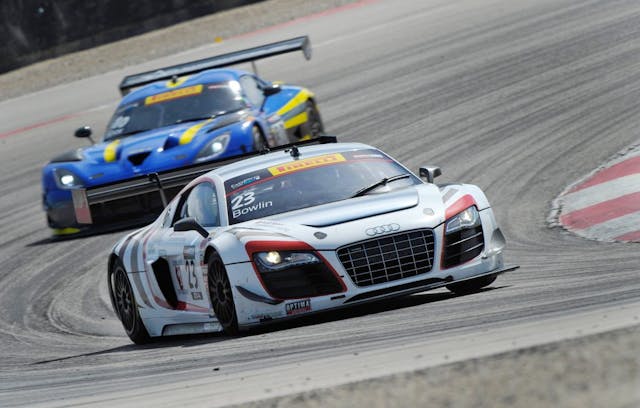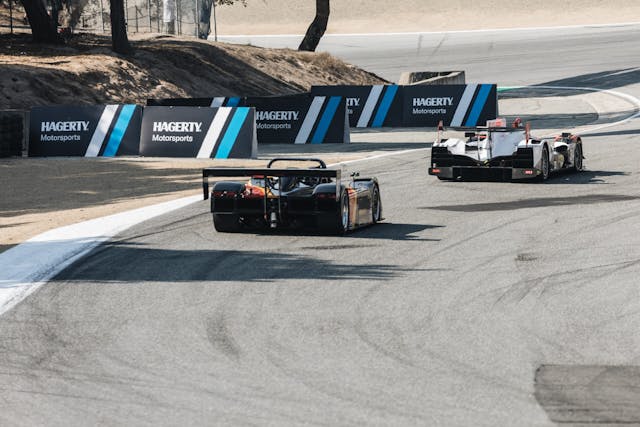Why vintage race cars are becoming less… vintage
Amenacing-looking Oreca LMP2 car with a byzantine array of aerodynamic aids glides to a halt in the paddock at WeatherTech Raceway Laguna Seca. A driver wriggles out of the cockpit wearing the customary accoutrements of driving gear demanded by a high-downforce prototype—HANS Device, custom-molded earpieces, kneepads. It looks like someone who has just finished a pro race in IMSA’s top-run sports car series.
Actually, the driver, Danny Baker of San Francisco, is competing at the Rolex Monterey Motorsports Reunion—in a car built in 2011. Parked near century-old Indy cars and post-war specials, the Oreca seems as alien as an F-22 among biplanes. But as Baker puts it, “This is probably the future of vintage racing.”
Once upon a time, there was nothing more superfluous than an old race car, and if it wasn’t dumped in a corner or cannibalized for parts, it was unloaded for pennies on the dollar. Then, in 1974, visionary Steve Earle staged the first Monterey Historic Automobile Races at Laguna Seca. By establishing a high-profile venue for vintage racing, the Monterey Historics—which morphed into the Rolex Reunion—created a market for obsolete warhorses.
The sport has been in a state of constant change ever since. In the beginning, monopostos from the 1930s were the big dogs. Later, it was 1950s Ferraris and then Le Mans racers from the ’70s. For the last few years, the Reunion has showcased dozens of seemingly modern GTP and GTO cars raced in the 1980s and even the ’90s.
This year, for the first time, the Reunion included a run group for the Masters Endurance Legends series, which caters to prototypes and GT cars from the 21st century. Many of them ran successfully in pro series up until a few years ago. In fact, an Audi R8 GT3 driven by David Roberts, a businessman from Carmel, Indiana, won Pirelli World Challenge races as recently as 2014. “It’s a fabulous car,” he says. “It makes an old man like me look fast.”
British vintage racer Ron Maydon founded Masters Endurance Legends in 2018 to complement his Masters Historic Formula 1 series, which focuses on analog cars from the Cosworth DFV era. “We’ve all got F1 cars. But we see the new cars and want to have a fling at them,” he says. “They’re more reliable, probably cheaper per mile to race and definitely safer.”
In many respects, they’re also easier to drive, because of power steering, anti-lock brakes and traction control. “I get out of the [2015 LMP3] Ligier after 40 minutes, and I feel like I’m ready for a jog,” Maydon says. “I get out of the [1977 LEC] F1 car after 20 minutes, and I feel like I want to die.”
Racing has always been a niche sport, and car owners who actually get behind the wheel themselves constitute a minute subset of motorsports fans. Even as street car performance ratchets ever upward and racing-adjacent activities such as track days proliferate, the number of people inspired to race wheel to wheel continues to dwindle.
I get out of the [2015 LMP3] Ligier after 40 minutes, and I feel like I’m ready for a jog. I get out of the [1977 LEC] F1 car after 20 minutes, and I feel like I want to die.
Ron Maydon, founder, Masters Endurance Legends
“For a lot of young collectors, their idea of ‘racing’ is renting a track with a couple of friends and driving around in their McLaren Sennas,” says longtime racer Bruce Canepa, who restores and sells vintage race cars and exotics. “But it’s not like two or three guys going into Turn 2 at Laguna Seca and seeing who’s going to come out first.”
Attracting new blood is an especially acute problem in vintage racing. By its very nature, the sport looks backward in time, and people tend to feel nostalgic about what they loved while they were growing up. “What does a 50-year-old guy know about pre-war Bugattis?” says Keith Frieser, who’s racing an Oreca LMP2 car at the Reunion. “People want to race what they remember seeing on the racetrack themselves.”
Frieser is 60, which makes him something of a whippersnapper at the Reunion, where the drivers meetings resemble AARP seminars. This isn’t to say that younger people don’t appreciate older cars. But you need deep pockets to compete in this arena, and it’s hard to accumulate the necessary coin when you’re in your 20s or 30s. “We’ve got to make it more affordable,” Canepa says.
Enter GT3 race cars—lots and lots of GT3 cars. Developed in 2006 to appeal to gentleman drivers, the GT3 class has achieved huge worldwide success by creating venues for turnkey, factory-supported race cars designed to achieve very exacting performance standards. Thousands of GT3 cars have been built by manufacturers ranging from Porsche to Bentley.
Predictably, the prices of these cars plummet as new iterations render older models obsolete. Figure somewhere in the neighborhood of $500,000 for a factory-fresh example, with a spares package. A used one will run you less than half that. Mike Sheehan, who deals in collector cars as well as racing himself, picked up a 2010 Lamborghini Gallardo GT3 for $130,000, all in. Cars from single-make series, such as Ferrari Challenge and Maserati Trofeo, are even cheaper.
“Most of the half-serious clubs have a few grids for the older, pure cars and others for the newer ones that pay the bills.”
Thor Thorson
Although old GT3 cars are no longer competitive in pro racing, there are plenty of sandboxes for them to play in. The GT Celebration series was created last year primarily to give these cars a home. And while old GT3 cars are still newish, many vintage-racing groups now embrace them with open arms. “Most of the half-serious clubs have a few grids for the older, pure cars,” says vintage race veteran Thor Thorson, who also prepares vintage race cars for customers, “and others for the newer ones that pay the bills.”
Now the bad news: Even though GT3 machines are exquisitely built works of mechanical art, they’re probably not going to appreciate in value. Too many were built, so they’ll always be the motorsports version of secondhand cars. Or as Sheehan puts it, “They’re just cheap thrills.”
Prototypes are even more thrilling. Also—no surprise—more expensive. But they might offer a better return on investment.

Prototypes come in two basic flavors—Daytona Prototypes and Le Mans Prototypes. DPs, built from 2003 to 2016, brought a quasi-NASCAR design ethos to endurance road racing, which is to say that they’re super robust and relatively straightforward. The signature feature of early models—a tall greenhouse, adopted primarily for safety reasons—made for notoriously ugly bodywork, but the spacious cockpit is perfect for gentleman drivers.
By way of contrast, the sleek LMP cars look stunning. They’re also more exotic than the DPs, with way more downforce and a suite of sophisticated electronic controls. To balance an LMP car on the limit isn’t for the faint of heart. “Driving this car is a very humbling experience,” Baker says, sweaty and flushed, after a session in his LMP2 Oreca.
Prices are all over the map. You can find DPs and P3s starting around $150,000, and P2s closer to $500,000. LMP1 cars—the models competing for overall wins at Le Mans—tend to be significantly more precious. These are serious pieces of kit, and you’ll need a knowledgeable crew to run them. Even these rare vehicles are considered track-day weapons rather than long-term investments—unless, of course, a particular chassis has high-profile results in its logbook.
“I think the modern Formula 1 cars are definitely collectible,” says premier race car collector Charlie Nearburg, who campaigns an LMP2 in Europe (in addition to a bunch of killer cars here in the States). “But when you’re talking about sports prototypes, you have to get into historic success.”
All to say, buying a modern race car probably isn’t the wisest wealth-accumulation strategy in the world. If you’re after unparalleled fun for your money, though, used prototypes and GT3 cars have a lot to offer. Consider these lap times from the Reunion posted by acknowledged hot shoes in multi-million-dollar blue-chip collectibles:
- Nearburg, in a 1981 Williams FW07C – 1:21.533
- Canepa, in a 1989 Porsche 962C – 1:29.329
- Nearburg, in a 1980 Porsche 935K3 – 1:33.180
- Gunnar Jeannette, in a 1969 Ford GT40 – 1:34.917
Compare these times with ones posted in the Masters Endurance Legends race:
- Spencer Trenery, in 2006 Riley DP – 1:24.419
- Baker, in a 2011 Oreca LMP2 – 1:25.386.
- Roberts, in a 2013 Audi R8 GT3, 1:34.133
If you do the math, it’s hard not to be impressed by the modern cars, especially when you factor in how much safer and more reliable they are than the older machinery. At the moment, the pool of these models is deep, and only a handful of people are testing the waters. But that’s bound to change as a generation of fans who grew up with Gran Turismo and flag-to-flag endurance-racing coverage start accruing large caches of disposable income.
“The young people are still making their way, but they’ll appreciate these cars later,” says Carlos De Quesada, who ran a 2004 Porsche 911 RSR in the Masters Endurance group. “Everyone wants to go faster. So there will be an interest in these cars.”
***
Check out the Hagerty Media homepage so you don’t miss a single story, or better yet, bookmark it. To get our best stories delivered right to your inbox, subscribe to our newsletters.


